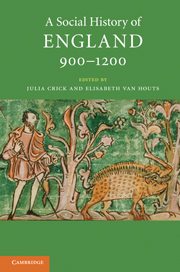Book contents
- Frontmatter
- Contents
- List of figures
- List of maps and tables
- List of contributors
- Acknowledgements
- List of abbreviations
- Map 1 England and its neighbours
- Map 2 England 900–1200
- I Introduction
- I.1 Land use and people
- I.2 Water and land
- I.3 Forest and upland
- I.4 Mineral resources
- I.5 Health and disease
- II.1 Authority and community
- II.2 Lordship and labour
- II.3 Order and justice
- II.4 War and violence
- II.5 Family, marriage, kinship
- II.6 Poor and powerless
- III.1 Towns and their hinterlands
- III.2 Commerce and markets
- III.3 Urban planning
- III.4 Urban populations and associations
- IV.1 Invasion and migration
- IV.2 Ethnicity and acculturation
- IV.3 Intermarriage
- IV.4 The Jews
- V.1 Religion and belief
- V.2 Rites of passage and pastoral care
- V.3 Saints and cults
- V.4 Public spectacle
- V.5 Textual communities (Latin)
- V.6 Textual communities (vernacular)
- VI.1 Learning and training
- VI.2 Information and its retrieval
- VI.3 Esoteric knowledge
- VI.4 Medical practice and theory
- VI.5 Subversion
- Glossary
- Time line 900–1200
- Further reading
- Index
V.5 - Textual communities (Latin)
Published online by Cambridge University Press: 05 June 2012
- Frontmatter
- Contents
- List of figures
- List of maps and tables
- List of contributors
- Acknowledgements
- List of abbreviations
- Map 1 England and its neighbours
- Map 2 England 900–1200
- I Introduction
- I.1 Land use and people
- I.2 Water and land
- I.3 Forest and upland
- I.4 Mineral resources
- I.5 Health and disease
- II.1 Authority and community
- II.2 Lordship and labour
- II.3 Order and justice
- II.4 War and violence
- II.5 Family, marriage, kinship
- II.6 Poor and powerless
- III.1 Towns and their hinterlands
- III.2 Commerce and markets
- III.3 Urban planning
- III.4 Urban populations and associations
- IV.1 Invasion and migration
- IV.2 Ethnicity and acculturation
- IV.3 Intermarriage
- IV.4 The Jews
- V.1 Religion and belief
- V.2 Rites of passage and pastoral care
- V.3 Saints and cults
- V.4 Public spectacle
- V.5 Textual communities (Latin)
- V.6 Textual communities (vernacular)
- VI.1 Learning and training
- VI.2 Information and its retrieval
- VI.3 Esoteric knowledge
- VI.4 Medical practice and theory
- VI.5 Subversion
- Glossary
- Time line 900–1200
- Further reading
- Index
Summary
Latin texts played a central role in the life of all religious institutions, in a way that set them apart from the laity. Monks, nuns and clergy encountered such texts daily, through the communal performance of the liturgy and other customary observances, individual devotional reading and study. Levels of knowledge and comprehension of Latin varied considerably both within and between religious institutions. Nevertheless, the concept of a textual community, as formulated by Brian Stock, accommodates the existence of differing levels of literacy within a single such community. Membership involved a shared understanding of the contents or precepts of a text or group of texts which shaped or reinforced their ideals and identity. Stock's detailed analysis focused primarily upon Continental marginal and heretical groups, but he acknowledged that textual communities also existed within the religious mainstream. England did not experience the emergence of Christian heterodox or dissident groups until the late Middle Ages, and, in all but exceptional cases, the laity's inclusion as part of a textual community required the use of the vernacular. The number of Latinate laymen was not sufficient to obviate the equation of clericus and litteratus, at a time when to be literate was understood to entail an ability to read Latin.
- Type
- Chapter
- Information
- A Social History of England, 900–1200 , pp. 330 - 340Publisher: Cambridge University PressPrint publication year: 2011
- 1
- Cited by



